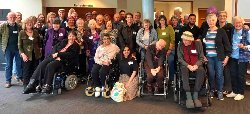Waikato University geography student crimefighter
Waikato University geography student joins fight
against crime
When do most arson attacks
occur in the Waikato? And are you more likely to be
assaulted in Hamilton or Whitianga over the summer? For
hi-tech help in pinpointing where and when crime happens,
best turn to a geographer.
One University of Waikato geography student has been looking at ways to help police better visualise crime patterns by using different software packages to reveal the spatial and temporal geographies of crime.
“If we can identify key crime ‘hot spots’, then the police can better allocate resources to fight those crimes,” says Geoff Hughes, who’s just completed a Summer Research Scholarship project analysing police crime data in the Waikato region over a ten-year period.
Hughes works in the field of geographical information systems (GIS), an up and coming area of study that uses mapping software to capture and analyse data relating to location. GIS applications are used for ecological modelling, population accessibility to services – and now for crime busting.
For the summer research project, Hughes worked with Associate Professor Lex Chalmers and Dr Lars Brabyn of the Department of Geography Tourism and Environmental Planning (GTEP) to look at distribution in time and place of three different offences – burglary, assault and arson.
“It was a good opportunity to try out different types of visualisation methods and draw some conclusions from the analysis,” says Hughes, who last year delivered a report to the Waikato police based on earlier research analysing the influence of public holidays on crime.
The summer research project revealed some interesting patterns. In Hamilton, the Hillcrest area was the target of a high level of burglaries in January – perhaps because that’s when students tend to be away, suggests Hughes.
He also found a link between poorer areas of the city and a higher incidence of burglary and assault.
Less obvious patterns he’s found include a higher occurrence of assault in the Coromandel beach towns over the summer holiday period, compared to elsewhere in the Waikato, and the fact that most arson attacks occur in October and November.
“The timing coincides with the end of the school year, so it could indicate that bored teenagers are involved,” says Hughes. “There’s also quite a high number of arson attacks at Easter, on Labour Day and in the school holidays.”
Hughes is now embarking on Masters-level research, and plans to focus on the distribution of assaults in Hamilton’s entertainment precincts, using more advanced mapping techniques.
The University of Waikato’s Summer Research Scholarships are offered each year to promising undergraduate, honours and first year masters students. They are for ten weeks and come with a $5,000 stipend for the student and provide supervisors with an extra pair of hands for their research projects.
ENDS


 Melanie Allison: Local Playwright Casts A Spell Over Hamilton
Melanie Allison: Local Playwright Casts A Spell Over Hamilton Te Kohao Health: New $12M Wellness & Diagnostic Centre Opens In Hamilton ‘Disrupting The Historic Continuum’ For Māori
Te Kohao Health: New $12M Wellness & Diagnostic Centre Opens In Hamilton ‘Disrupting The Historic Continuum’ For Māori Vegetables NZ: Fresh NZ-grown Vegetables Now Even Better Value For Cash Strapped Kiwis
Vegetables NZ: Fresh NZ-grown Vegetables Now Even Better Value For Cash Strapped Kiwis AgriFutures: Supporting The Next Generation To Succeed In Agriculture And Horticulture
AgriFutures: Supporting The Next Generation To Succeed In Agriculture And Horticulture Asian Aotearoa Arts: New Crops, Conversations And Illuminations: Asian Aotearoa Arts 2024 Full Programme Announcement
Asian Aotearoa Arts: New Crops, Conversations And Illuminations: Asian Aotearoa Arts 2024 Full Programme Announcement Arts Access Aotearoa: Accessing The Benefits Of Music Therapy
Arts Access Aotearoa: Accessing The Benefits Of Music Therapy